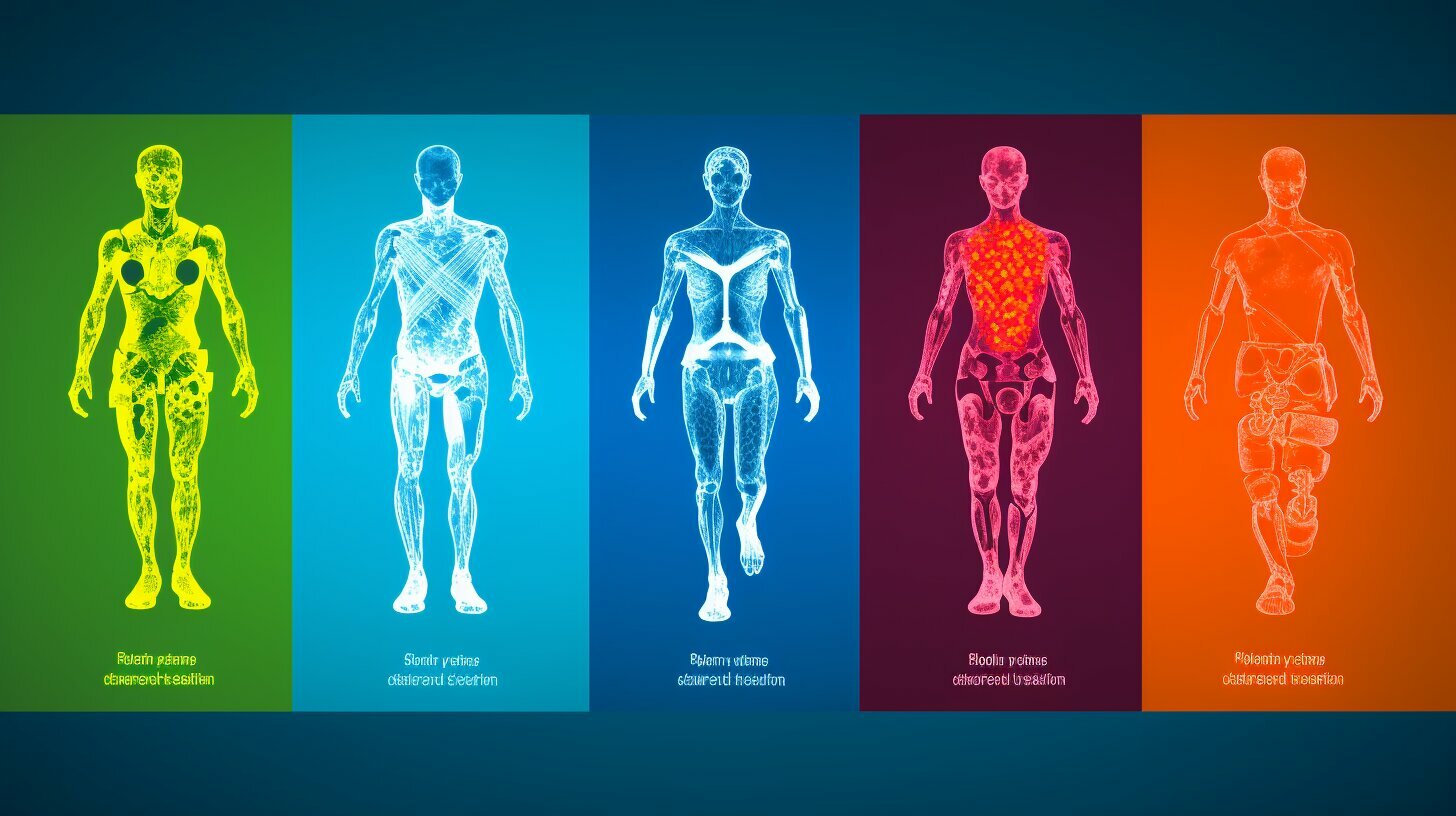A properly equipped first aid kit is crucial for effectively managing and treating common injuries in the UK. Whether at home, in the workplace, or during outdoor activities, having the right supplies readily available can make a significant difference in providing immediate care and preventing further complications.
First aid kits should contain a comprehensive range of supplies, including plasters, gauze dressings, eye dressings, bandages, safety pins, gloves, tweezers, scissors, cleansing wipes, tape, thermometer, rash cream, insect bite relief, antiseptic cream, painkillers, antihistamine, distilled water, and an eye wash. These essential items cater to a wide range of injuries and emergencies, ensuring that proper care and hygiene are maintained.
Regularly checking the first aid kit for expired supplies and replacing them is essential to ensure the effectiveness of the kit. In addition, having a first aid manual as a reference guide is invaluable in understanding how to use the supplies correctly and efficiently.
First aid kits not only provide the necessary tools for immediate treatment, but they also have the potential to save lives and prevent injuries from worsening. By promptly administering proper first aid, individuals can play a crucial role in stabilizing a situation until professional medical help arrives.
Whether it’s at home, in the workplace, or during outdoor activities, prioritizing emergency preparedness by having a well-stocked first aid kit can make all the difference in ensuring the health and safety of oneself and others.
Understanding the Importance of First Aid Kits
A well-stocked first aid kit plays a key role in preventing further harm and ensuring immediate care during emergencies. Injury prevention should always be a top priority, and having a first aid kit readily available in homes and workplaces is a crucial step towards achieving this. In times of distress, a properly equipped first aid kit can provide the necessary supplies to address minor accidents and injuries promptly.
Emergency preparedness is another vital aspect of first aid kits. By having essential items on hand, individuals can be prepared to handle a wide range of common injuries effectively. Whether it’s a cut, a sprain, or a burn, a well-stocked first aid kit can provide the supplies needed to offer immediate care and prevent injuries from worsening.
To further enhance the effectiveness of first aid kits, it’s essential to have access to reliable first aid treatment guides. These guides provide valuable information on how to administer proper care in different situations. They serve as a reference point for individuals who may not be trained in medical procedures but need to provide immediate assistance during an emergency.
| Essential First Aid Kit Components | Additional First Aid Supplies |
|---|---|
| Plasters | Eye dressings |
| Gauze dressings | Tape |
| Bandages | Thermometer |
| Safety pins | Rash cream |
| Gloves | Insect bite relief |
| Tweezers | Antiseptic cream |
| Scissors | Painkillers |
| Cleansing wipes | Antihistamines |
Regularly checking the first aid kit is crucial to ensuring that all supplies are up to date and in proper working condition. Medications should be checked for expiration dates, and any expired items should be replaced promptly. Additionally, keeping the kit in a locked, cool, and dry place, out of reach of children, helps maintain the effectiveness and integrity of the supplies.
In conclusion, a well-stocked first aid kit is an invaluable asset for any household or workplace. It aids in injury prevention, emergency preparedness, and immediate care. By familiarizing ourselves with its contents and regularly maintaining it, we equip ourselves with the necessary tools to save lives and prevent injuries from worsening.
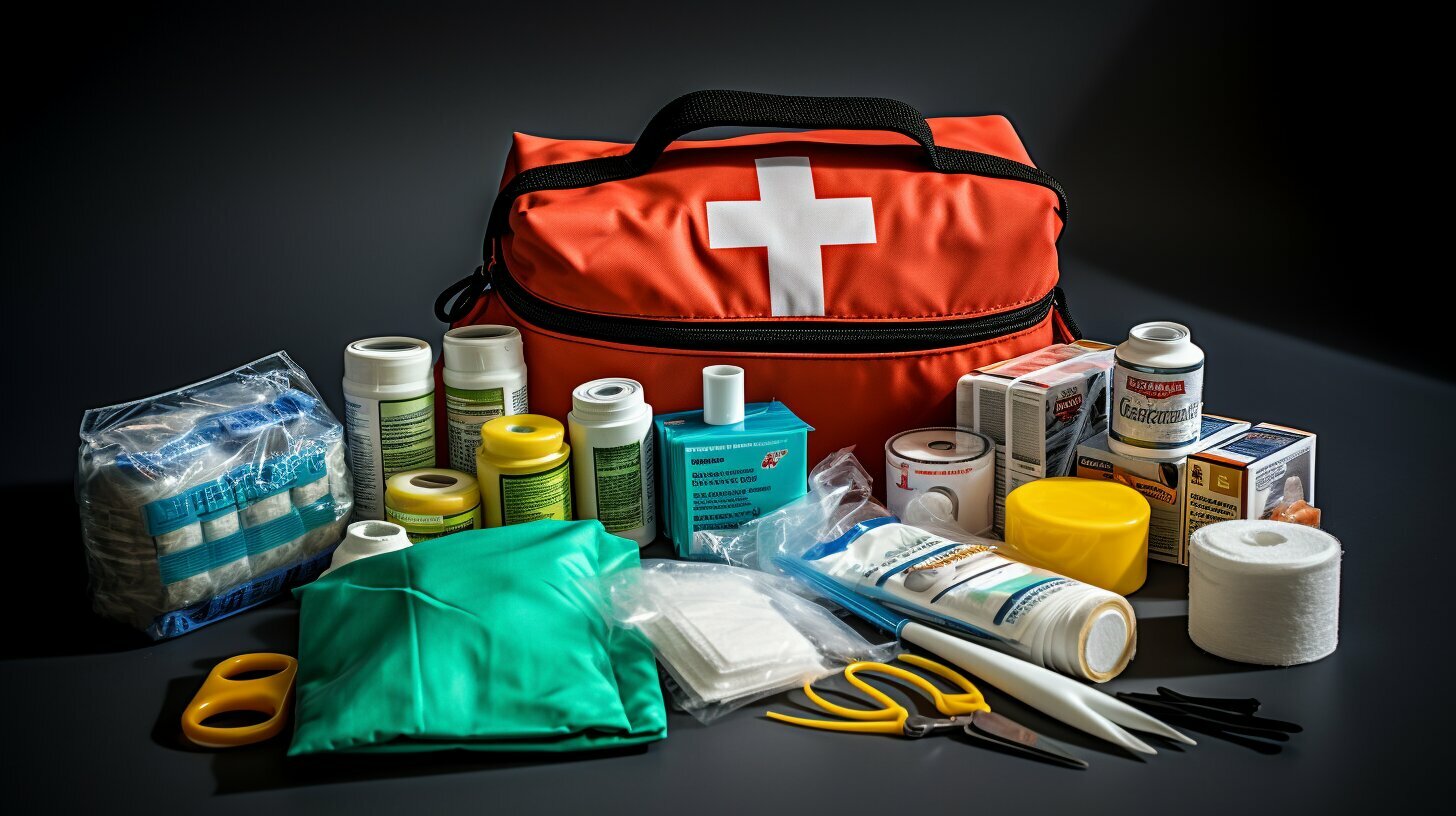
A basic first aid kit should contain a range of essential items, including plasters, gauze dressings, bandages, safety pins, gloves, tweezers, scissors, and cleansing wipes. These items are crucial for treating minor injuries and preventing infection.
The first item that should be in every first aid kit is plasters. They are used to cover small cuts, grazes, and blisters, providing protection and promoting healing. Gauze dressings are another essential component, as they help control bleeding and can be used to dress larger wounds.
Bandages are also vital for securing dressings in place, immobilizing injured limbs, and providing support for strains and sprains. Safety pins are included to fasten bandages securely. Gloves are crucial to prevent cross-contamination and protect both the caregiver and the injured person.
Tweezers and scissors come in handy for removing splinters, cutting tape or gauze, and trimming dressings to fit the wound. Cleansing wipes are essential for cleaning the skin around wounds before applying dressings, reducing the risk of infection.
| Essential Items | Uses |
|---|---|
| Plasters | To cover small cuts, grazes, and blisters |
| Gauze dressings | To control bleeding and dress larger wounds |
| Bandages | To secure dressings, immobilize limbs, and provide support |
| Safety pins | To fasten bandages securely |
| Gloves | To protect against cross-contamination |
| Tweezers | To remove splinters and foreign objects |
| Scissors | To cut tape, gauze, and dressings |
| Cleansing wipes | To clean the skin around wounds |
Having these key components in a first aid kit ensures that you are prepared to provide immediate care in case of minor accidents or injuries. Remember to regularly check your kit to replace any expired supplies and keep it in a locked, cool, dry place, out of reach of children.

A well-stocked first aid kit is essential for handling minor injuries and preventing complications. It should include plasters, gauze dressings, bandages, safety pins, gloves, tweezers, scissors, and cleansing wipes. These components allow for immediate care and protection against infection. Regularly checking the kit and storing it in a safe place ensures its effectiveness in times of need.
Additional First Aid Supplies for Specific Injuries
In addition to the basic first aid supplies, it is essential to include specific items like eye dressings, tape, and rash cream for comprehensive injury care. Eye dressings are crucial for protecting and covering eye injuries, preventing further damage while providing a barrier against infection. It is important to have different sizes and shapes of eye dressings to accommodate various eye injuries.
Tape is another indispensable item that should be included in a first aid kit. It is used to secure dressings and bandages in place, ensuring proper wound care. The tape should be adhesive enough to hold firmly, but also gentle enough to be easily removed without causing discomfort.
Rashes and insect bites are common occurrences that require immediate attention. Including rash cream and insect bite relief in the first aid kit can provide soothing relief and help alleviate discomfort. These topical treatments can help reduce itching, inflammation, and redness, promoting faster healing of skin irritations.
Antiseptic cream is another essential item that should be included in the first aid kit. It helps prevent infection by killing bacteria and germs on the skin surface. Painkillers, such as paracetamol or ibuprofen, can also be included to provide temporary relief from pain and reduce discomfort caused by minor injuries.
Table: Additional First Aid Supplies
| Item | Function |
|---|---|
| Eye dressings | Protect and cover eye injuries |
| Tape | Secure dressings and bandages in place |
| Rash cream | Soothe and heal skin rashes |
| Insect bite relief | Alleviate discomfort from insect bites |
| Antiseptic cream | Prevent infection |
| Painkillers | Provide temporary relief from pain |
By including these additional first aid supplies in your kit, you can ensure that you are prepared to address a wider range of injuries and provide effective care when needed. Remember to regularly check and replace expired items in your first aid kit to maintain its effectiveness. Having a well-stocked first aid kit can make a significant difference in managing injuries and ensuring the well-being of yourself and others.

Regularly checking the first aid kit for expired supplies and having a comprehensive first aid manual is crucial for maintaining the effectiveness of your first aid kit. First aid kits are essential for dealing with minor accidents and injuries, so it’s important to ensure that all the supplies are up to date and in good condition.
One of the key aspects of maintaining a first aid kit is checking the expiration dates of medications and other perishable items. Expired supplies may not be as effective or could even cause harm if used. By regularly checking and replacing any expired items, you can ensure that your first aid kit is always ready to provide the necessary care.
In addition to checking expiration dates, having a comprehensive first aid manual is vital. It serves as a reference guide for proper usage of the supplies in your kit. The manual provides instructions on how to administer first aid treatments correctly, giving you the confidence to handle emergencies effectively. It may also include additional information on specific injuries and treatments, ensuring that you are well-prepared for various situations.
Remember, accidents can happen at any time, so it’s crucial to have a well-stocked and well-maintained first aid kit. Regularly checking for expired supplies and having a reliable first aid manual will ensure that you are ready to provide immediate care when it matters most.
| Essential Supplies for First Aid Kit |
|---|
| Plasters |
| Gauze dressings |
| Eye dressings |
| Bandages |
| Safety pins |
| Gloves |
| Tweezers |
| Scissors |
| Cleansing wipes |
| Tape |
| Thermometer |
| Rash cream |
| Insect bite relief |
| Antiseptic cream |
| Painkillers |
| Antihistamine |
| Distilled water |
| Eye wash |
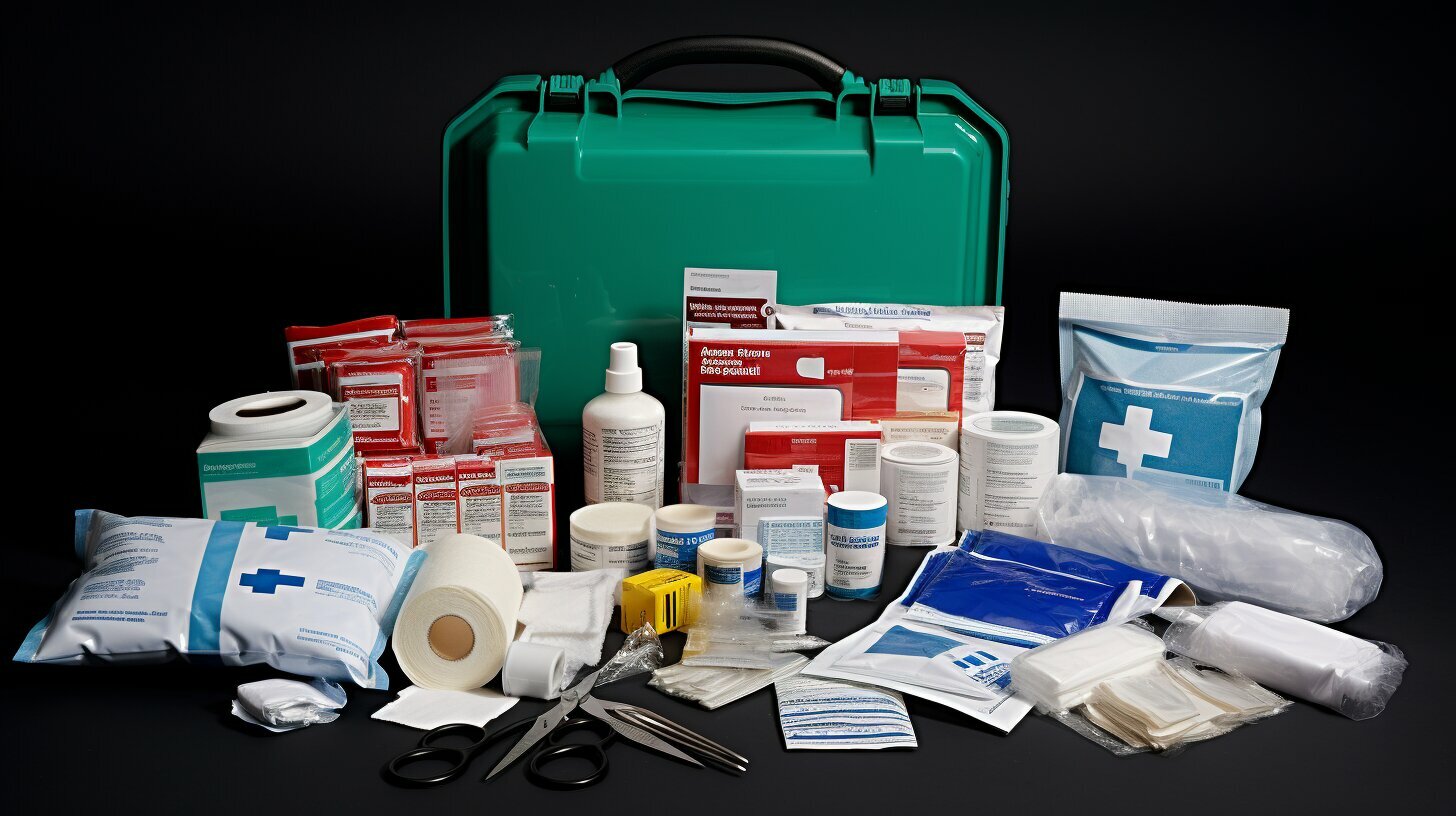
Proper Storage of First Aid Kits
Storing your first aid kit in a secure, cool, and dry place, away from children’s reach, is essential for maintaining its effectiveness. Proper storage ensures that the supplies remain in optimal condition and are readily accessible in case of an emergency.
A locked cabinet or drawer is an ideal location for your first aid kit, as it prevents unauthorized access while keeping it easily accessible to those who need it. A cool and dry environment helps preserve the integrity of the supplies, preventing moisture or heat from compromising their effectiveness.
Children are naturally curious and may be tempted to explore the contents of a first aid kit. To prevent any accidents or misuse of the supplies, it’s crucial to place the kit out of their reach. This not only safeguards their well-being but also ensures that the kit is readily available for adults to use in case of emergencies.
Proper Storage Checklist:
- Keep the first aid kit in a locked cabinet or drawer
- Ensure the storage area is cool and dry
- Place the kit out of children’s reach
- Regularly check the supplies for expiration dates and replenish as needed
By following these storage guidelines, you can be confident that your first aid kit is always prepared and ready to assist during minor accidents or injuries. Remember to periodically check the supplies and replace any expired items to maintain the kit’s effectiveness.
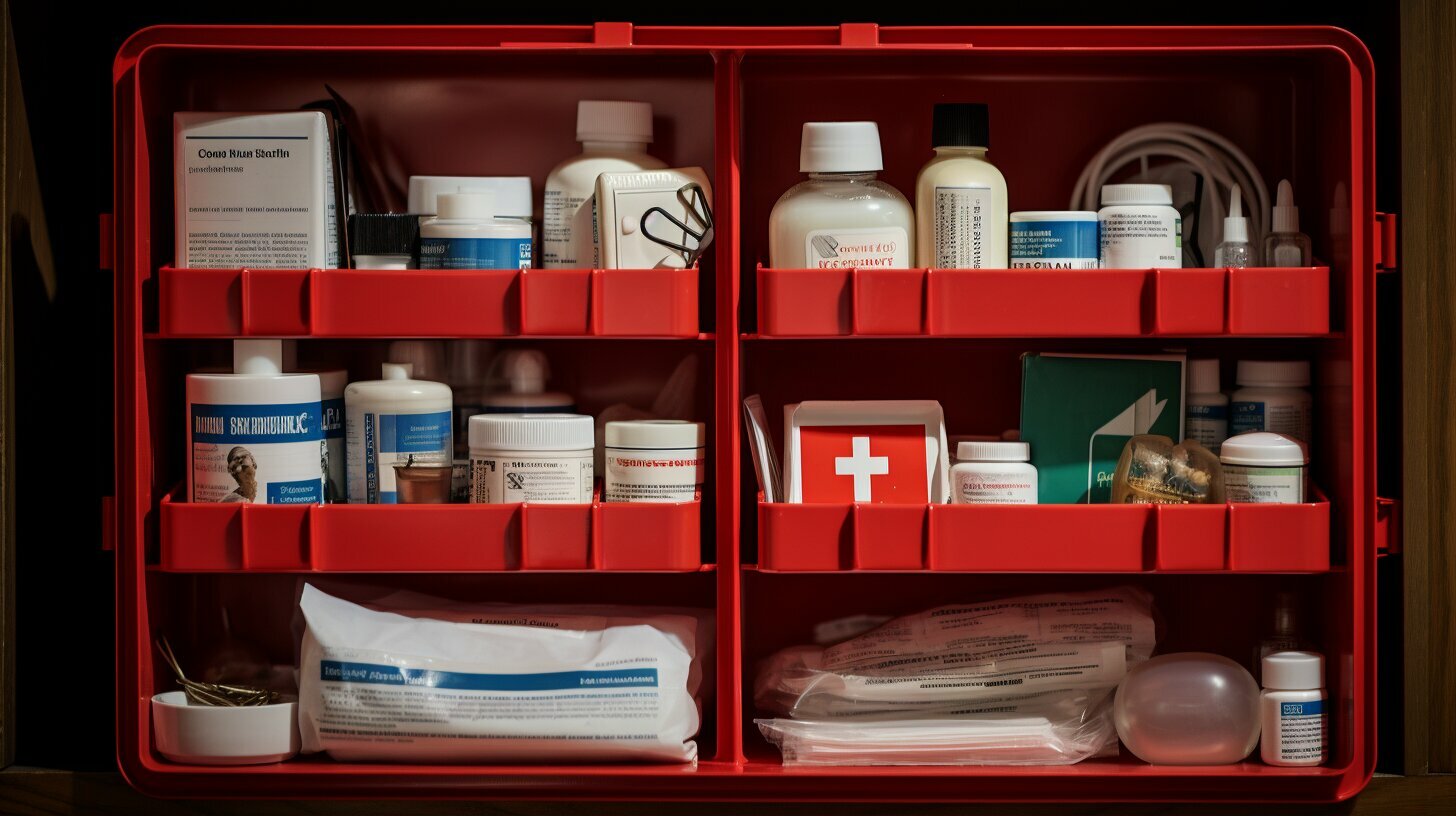
| First Aid Kit Supplies | Quantity |
|---|---|
| Plasters | 10 |
| Gauze Dressings | 4 |
| Eye Dressings | 2 |
| Bandages | 4 |
| Safety Pins | 6 |
| Gloves | 2 pairs |
| Tweezers | 1 |
| Scissors | 1 |
| Cleansing Wipes | 10 |
| Tape | 1 roll |
| Thermometer | 1 |
| Rash Cream | 1 tube |
| Insect Bite Relief | 1 tube |
| Antiseptic Cream | 1 tube |
| Painkillers | 1 pack |
| Antihistamine | 1 pack |
| Distilled Water | 1 bottle |
| Eye Wash | 1 bottle |
The Lifesaving Potential of First Aid Kits
A well-prepared first aid kit has the potential to save lives and mitigate the severity of injuries in emergency situations. Whether at home, in the workplace, or during outdoor activities, having a well-stocked first aid kit is essential for providing immediate care and preventing injuries from worsening.
In a first aid kit, you should include a range of essential supplies to handle various injuries. These items may include plasters, gauze dressings, bandages, gloves, tweezers, scissors, and cleansing wipes. Additionally, eye dressings, tape, and a thermometer are useful for treating specific injuries. Providing relief from insect bites, rashes, and minor pains can be achieved through the inclusion of rash cream, antiseptic cream, painkillers, and antihistamines.
Regularly checking the first aid kit for expiration dates is crucial to ensure the effectiveness of the supplies. It is also advisable to have a first aid manual on hand, as it serves as a valuable reference guide for proper usage of the supplies.
| Essential First Aid Supplies | Additional First Aid Supplies |
|---|---|
| Plasters | Eye dressings |
| Gauze dressings | Tape |
| Bandages | Thermometer |
| Gloves | Rash cream |
| Tweezers | Insect bite relief |
| Scissors | Antiseptic cream |
| Cleansing wipes | Painkillers |

Proper storage of the first aid kit is crucial to preserve the integrity of the supplies. It should be kept in a locked, cool, and dry place, out of reach of children. By following these guidelines, you ensure that the supplies remain in optimal condition and are readily accessible when needed.
Remember, a well-prepared first aid kit is not only a necessity but also a potential lifesaver. It enables you to respond promptly and effectively in emergency situations, saving lives and preventing injuries from worsening. Take the time to ensure your first aid kit is adequately stocked and properly maintained to maximize its lifesaving potential.
First Aid Kits in the Workplace
First aid kits are vital in maintaining workplace safety and providing immediate care for occupational injuries. Accidents and injuries can happen anywhere, including the workplace, which is why it is crucial to have a well-equipped first aid kit readily available. These kits are designed to provide essential supplies and treatments that can make a significant difference in emergency situations.
When it comes to workplace safety, having a comprehensive first aid kit is a legal requirement in many countries, including the UK. This ensures that employees have access to the necessary tools and supplies to address minor accidents and injuries. A properly stocked first aid kit can help prevent injuries from worsening and provide immediate care until professional medical help arrives.
What should a workplace first aid kit contain? Here is a list of some essential items:
| Essential Items | Use |
|---|---|
| Plasters | To cover minor cuts and grazes |
| Gauze Dressings | For wound dressing and protection |
| Eye Dressings | To treat eye injuries and protect the eyes |
| Bandages | For securing dressings and supporting injured limbs |
| Safety Pins | To fasten bandages and dressings |
| Gloves | To protect the first aider and the casualty from contamination |
| Tweezers | For removing splinters or foreign objects |
| Scissors | To cut dressings, tapes, and clothing |
| Cleansing Wipes | To clean wounds |
| Tape | For securing dressings and bandages |
| Thermometer | To measure body temperature |
| Rash Cream | For soothing and treating skin rashes |
| Insect Bite Relief | To alleviate the discomfort of insect bites and stings |
| Antiseptic Cream | To prevent infection in minor wounds |
| Painkillers | For relieving pain and discomfort |
| Antihistamine | To treat allergic reactions |
| Distilled Water | For cleaning wounds and diluting solutions |
| Eye Wash | To flush chemicals or foreign objects from the eyes |
In addition to these supplies, it’s essential to have a first aid manual that provides instructions on how to use the items in the kit effectively. Regularly check and replenish the supplies in the first aid kit to ensure that nothing is expired or running low.
Remember, workplace safety is everyone’s responsibility. By having a well-stocked first aid kit and ensuring that employees are trained in basic first aid skills, you can create a safer work environment and be prepared for any emergency.
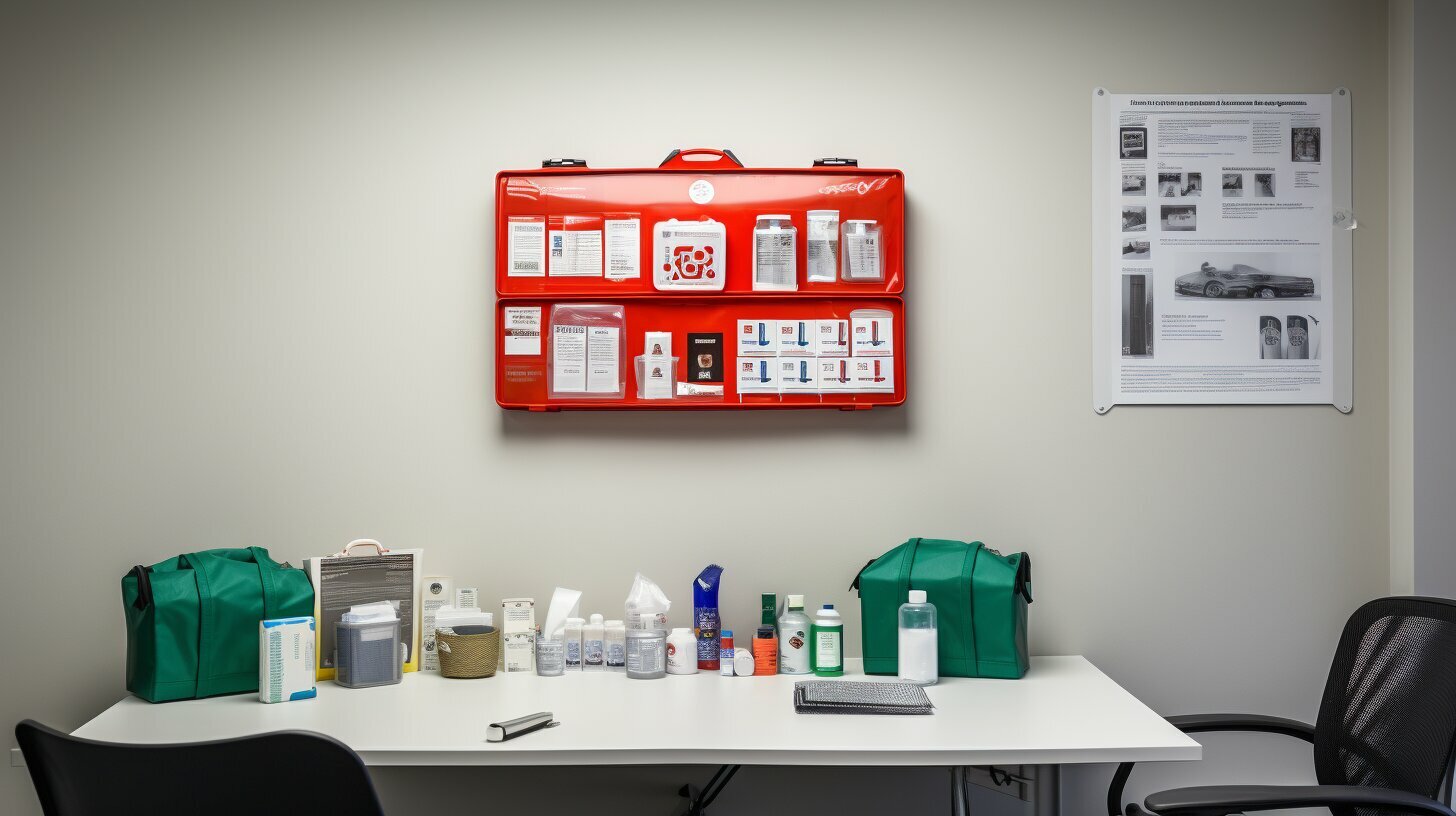
First Aid Kits for Outdoor Activities
Outdoor enthusiasts and adventurers should always carry a well-equipped first aid kit to ensure prompt treatment of sports injuries and manage emergencies in the wilderness. When engaging in outdoor activities such as hiking, camping, or participating in sports, accidents can happen, and it’s important to be prepared. A first aid kit specifically designed for outdoor use can provide essential supplies and tools to handle common injuries and emergencies.
Some of the key components that should be included in an outdoor first aid kit are plasters, gauze dressings, eye dressings, bandages, safety pins, gloves, tweezers, scissors, cleansing wipes, tape, thermometer, rash cream, insect bite relief, antiseptic cream, painkillers, and antihistamines. It’s also helpful to have distilled water and an eye wash for proper wound cleansing. These supplies cater to a wide range of injuries, including cuts, sprains, insect bites, and allergic reactions.
To ensure the first aid kit remains effective and ready for use, it is essential to regularly check and replenish supplies that have expired or been used. Additionally, having a first aid manual is highly recommended as it provides guidance on proper usage of the supplies and step-by-step instructions for administering first aid treatment in different situations.
| Essential Outdoor First Aid Kit Supplies | Use |
|---|---|
| Plasters | For covering small cuts and wounds |
| Gauze dressings | To control bleeding and cover larger wounds |
| Eye dressings | For protecting and covering eye injuries |
| Bandages | To secure dressings and support sprained joints |
| Safety pins | For securing bandages |
| Gloves | To protect the first aider from bodily fluids and prevent infection |
| Tweezers | For removing splinters and foreign objects |
| Scissors | To cut dressings or clothing if needed |
| Cleansing wipes | For cleaning wounds and minimizing the risk of infection |
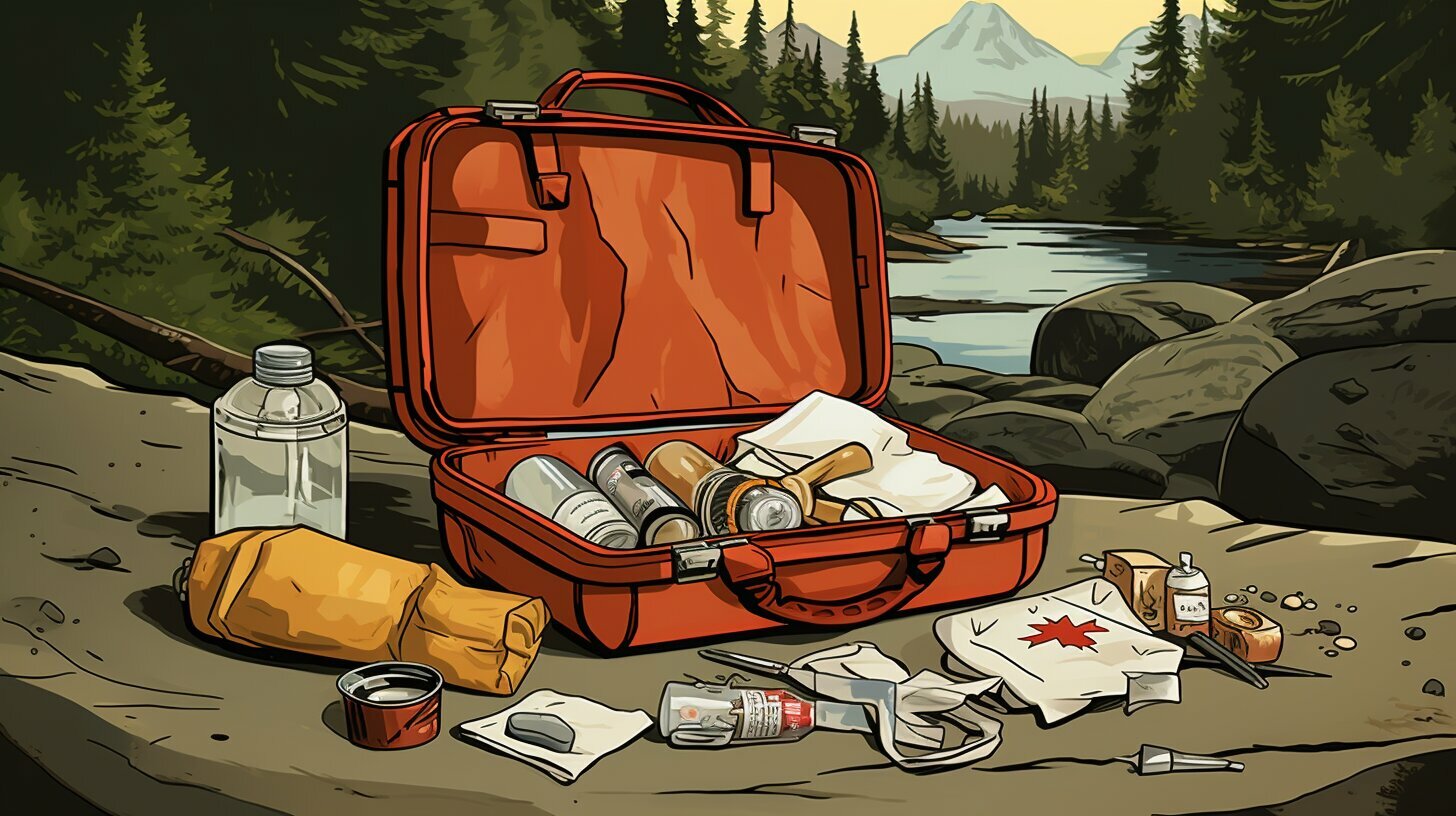
Having a well-stocked first aid kit with the necessary supplies for outdoor activities can make a significant difference in managing injuries and emergencies. By being prepared and carrying a first aid kit, outdoor enthusiasts can ensure prompt treatment, prevent complications, and enjoy their adventures with greater peace of mind.
Conclusion: Be Prepared, Stay Safe
Being prepared with a well-stocked first aid kit and the necessary knowledge can make all the difference in providing effective care during emergencies. In situations where every second counts, having the essential supplies readily available can help save lives and prevent injuries from worsening.
A basic first aid kit should include key components such as plasters, gauze dressings, eye dressings, bandages, safety pins, gloves, tweezers, scissors, and cleansing wipes. These items are vital for treating minor injuries and preventing infection. Additionally, supplies like tape, a thermometer, rash cream, insect bite relief, antiseptic cream, painkillers, and antihistamines cater to specific injuries and provide targeted relief.
It’s important to store your first aid kit in a locked, cool, and dry place, out of reach of children. Regularly checking the kit for expired supplies is crucial to ensure that all items are up to date and effective when needed. Having a first aid manual as a reference guide can also be invaluable in cases where immediate care is required.
Whether at home, in the workplace, or engaging in outdoor activities, having a well-equipped first aid kit is an essential part of emergency preparedness. By being proactive and equipping yourself with the necessary supplies and knowledge, you can ensure that you are ready to respond to accidents and injuries effectively, keeping yourself and others safe.
